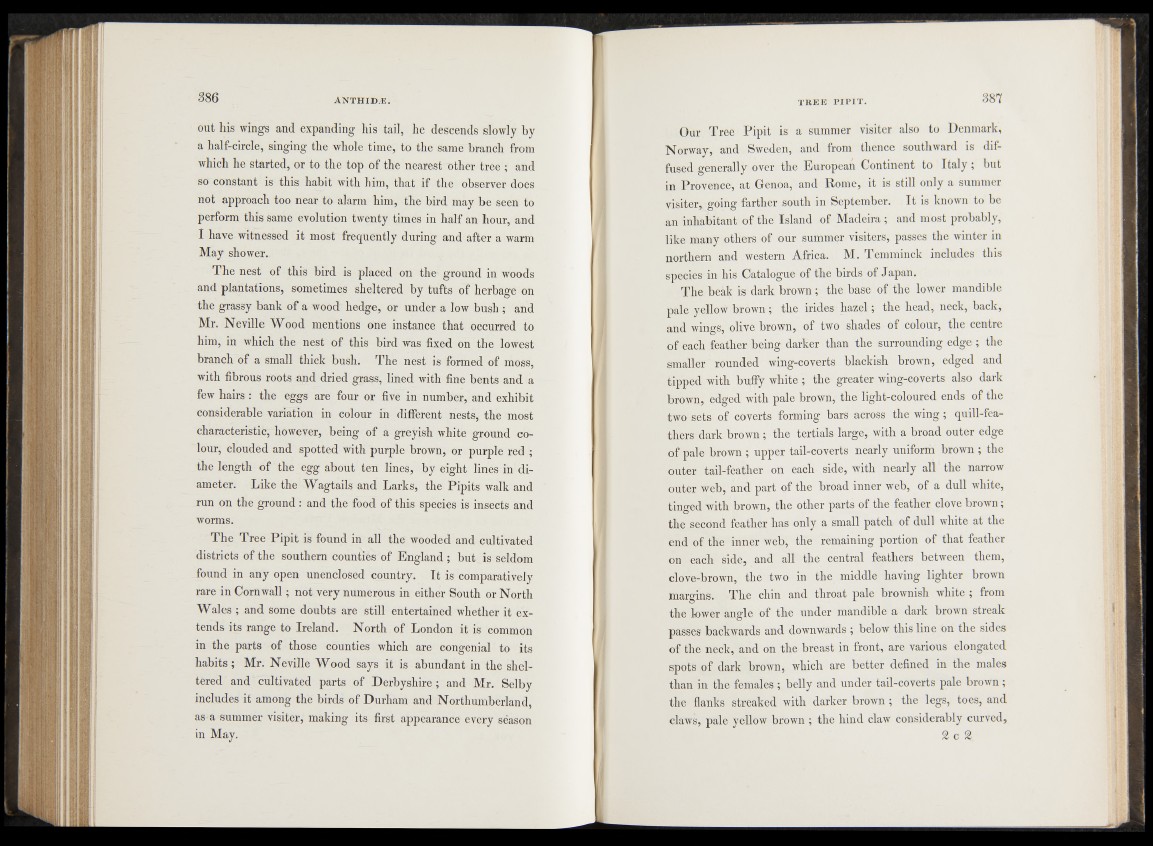
out his wings and expanding his tail, he descends slowly by
a half-circle, singing the whole time, to the same branch from
which he started, or to the top of the nearest other tree ; and
so constant is this habit with him, that if the observer does
not approach too near to alarm him, the bird may be seen to
perform this same evolution twenty times in half an hour, and
I have witnessed it most frequently during and after a warm
May shower.
The nest of this bird is placed on the ground in woods
and plantations, sometimes sheltered by tufts of herbage on
the grassy bank of a wood hedge, or under a low bush ; and
Mr. Neville Wood mentions one instance that occurred to
him, in which the nest of this bird was fixed on the lowest
branch of a small thick bush. The nest is formed of moss,
with fibrous roots and dried grass, lined with fine bents and a
few hairs : the eggs are four or five in number, and exhibit
considerable variation in colour in different nests, the most
characteristic, however, being of a greyish white ground colour,
clouded and spotted with purple brown, or purple red ;
the length of the egg about ten lines, by eight lines in diameter.
Like the Wagtails and Larks, the Pipits walk and
run on the ground: and the food of this species is insects and
worms.
The Tree Pipit is found in all the wooded and cultivated
districts of the southern counties of England; but is seldom
found in any open unenclosed country. It is comparatively
rare in Cornwall; not very numerous in either South or North
Wales ; and some doubts are still entertained whether it extends
its range to Ireland. North of London it is common
in the parts of those counties which are congenial to its
habits ; Mr. Neville Wood says it is abundant in the sheltered
and cultivated parts of Derbyshire ; and Mr. Selby
includes it among the birds of Durham and Northumberland,
as a summer visiter, making its first appearance every sëason
in May.
Our Tree Pipit is a summer visiter also to Denmark,
Norway, and Sweden, and from thence southward is diffused
generally over the European Continent to Ita ly ; but
in Provence, at Grenoa, and Rome, it is still only a summer
visiter, going farther south in September. It is known to be
an inhabitant of the Island of Madeira ; and most probably,
like many others of our summer visiters, passes the winter in
northern and western Africa. M. Temminck includes this
species in his Catalogue of the birds of Japan.
The beak is dark brown ; the base of the lower mandible
pale yellow brown; the irides hazel; the head, neck, back,
and wings, olive brown, of two shades of colour, the centre
of each feather being darker than the surrounding edge ; the
smaller rounded wing-coverts blackish brown, edged and
tipped with buffy white ; the greater wing-coverts also dark
brown, edged with pale brown, the light-coloured ends of the
two sets of coverts forming bars across the wing; quill-feathers
dark brown; the tertials large, with a broad outer edge
of pale brown ; upper tail-coverts nearly uniform brown ; the
outer tail-feather on each side, with nearly all the narrow
outer web, and part of the broad inner web, of a dull white,
tinged with brown, the other parts of the feather clove brown;
the second feather has only a small patch of dull white at the
end of the inner web, the remaining portion of that feather
on each side, and all the central feathers between them,
clove-brown, the two in the middle having lighter brown
margins. The chin and throat pale brownish white ; from
the lower anode of the under mandible a dark brown streak
passes backwards and downwards ; below this line on the sides
of the neck, and on the breast in front, are various elongated
spots of dark brown, which are better defined in the males
than in the females ; belly and under tail-coverts pale brown;
the flanks streaked with darker brown ; the legs, toes, and
claws, pale yellow brown ; the hind claw considerably curved,
2 c 2